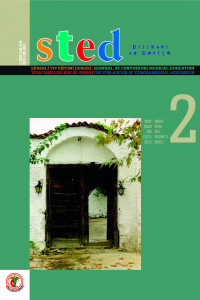Öz
Birinci basamakta ayaktan koruyucu ve tedavi edici sağlık hizmetlerini sunan aile hekimleri yaşlı ihmal ve/veya istismarı açısından özel bir yere sahiptir. Bu araştırmada, birinci basamakta hizmet sunan aile hekimlerinin yaşlı ihmali ve/veya istismarı konusundaki farkındalıklarının saptanması amaçlanmış olup veriler araştırmacılar tarafından çevrimiçi olarak hazırlanmış çevrimiçi veri toplama formu aracılığıyla toplanmıştır. Araştırmanın bulguları hekimlerin ihmal ve istismarı düşündürten genel görüşler, fiziksel durumlar, sosyal durumlar, hekimlerin ihmal ve/veya istismarı düşündüklerinde izledikleri yaklaşımlar ve yaptıkları uygulamalar olmak üzere üç kategoride sunulmuştur. Hekimlere ihmal ve/veya istismarı düşündüren bazı durumlar sunulmuş, sıralanan kategorilerden hiçbiri için, ihmal ve istismar durumu hekimlerin tamamı tarafından düşünülmemiştir. Bununla birlikte fiziksel belirtiler olduğunda, sosyal belirtilere göre daha fazla ihmal ve istismarı düşünmektedirler.
Bu durum, hekimlik uygulamaları sırasında daha somut olan belirtileri fark etmenin görece kolaylığı nedeniyle olabilir. Araştırmanın sonuçlarına göre; hekimlerin bilgi ve farkındalık düzeyleri her zaman istenilen davranışlara dönüşmemektedir. Kendilerine sunulan uygulama alanlarında bu eksiklikler görülmektedir. Hekimlerin yaşlı ihmal ve istismarı konusunda doğru uygulamaları yapabilmesi için, farkındalık durumlarının geliştirilmesinin yanı sıra davranış temelli eğitim olanaklarının da sunulması uygun olur.
Anahtar Kelimeler
Kaynakça
- 1-Phelan A. Elder abuse in the emergency department. International Emergency Nursing 2012;20:214-20.
- 2-Cooper C, Huzzey L, Livingston G. The effect of an educational intervention on junior doctors' knowledge and practice in detecting and managing elder abuse. Int Psychogeriatr. 2012 Sep;24(9):1447-53.
- 3-Cooper C, Selwood A, Livingston G. The prevalence of elder abuse and neglect: a systematic review. Age Ageing. 2008 Mar;37(2):151-60.
- 4-Selwood, A., Cooper, C. and Livingston, G. What Is Elder Abuse—Who Decides? International Journal of Geriatric Psychiatry,2007; 22: 1009-12.
- 5-Rosen T, Hargarten S, Flomenbaum NE, Platts-Mills TF. Identifying Elder Abuse in the Emergency Department: Toward a Multidisciplinary Team-Based Approach Ann Emerg Med. 2016; 68: 378–382.
- 6-Bell JA, May FE, Stewart RB. Clinical research in the elderly: ethical and methodological considerations. Drug Intell Clin Pharm 1987 Dec; 21(12): 1002-7. doi: 10.1177/106002808702101217.
- 7-Yaffe MJ, Tazkarji B. Understanding elder abuse in family practice. Can Fam Physician. 2012 Dec;58(12):1336-40, e695-8.
- 8-Kosberg JI, Lowenstein A, Garcia JL, Biggs S. Study of Elder Abuse Within Diverse Cultures, Journal of Elder Abuse & Neglect, 2003; 15:3-4, 71-89.
- 9-Storey JE. Risk factors for elder abuse and neglect: A review of the literatüre. Aggression and Violent Behavior 2020; 50:101339
- 10-Schiamberg LB, Oehmke J, Zhang Z, Barboza GE, Griffore RJ, Von Heydrich L. Physical abuse of older adults in nursing homes: a random sample survey of adults with an elderly family member in a nursing home. Journal of Elder Abuse & Neglect 2012; 24:65–83.
- 11-WHO fact sheet on elder maltreatment 0ct 4, 2021. Accessed 20 Feb 2022, at https://www.who.int/news-room/fact-sheets/detail/elder-abuse
- 12-Pillemer K, Burnes D, Riffin C, Lachs MS. Elder Abuse: Global Situation, Risk Factors, and Prevention Strategies. The Gerontologist 2016; 56 (Issue Suppl 2): S194–S205
Ayrıntılar
| Birincil Dil | Türkçe |
|---|---|
| Konular | Sağlık Kurumları Yönetimi |
| Bölüm | Orjinal Araştırma |
| Yazarlar | |
| Yayımlanma Tarihi | 29 Nisan 2022 |
| Yayımlandığı Sayı | Yıl 2022 Cilt: 31 Sayı: 2 |


